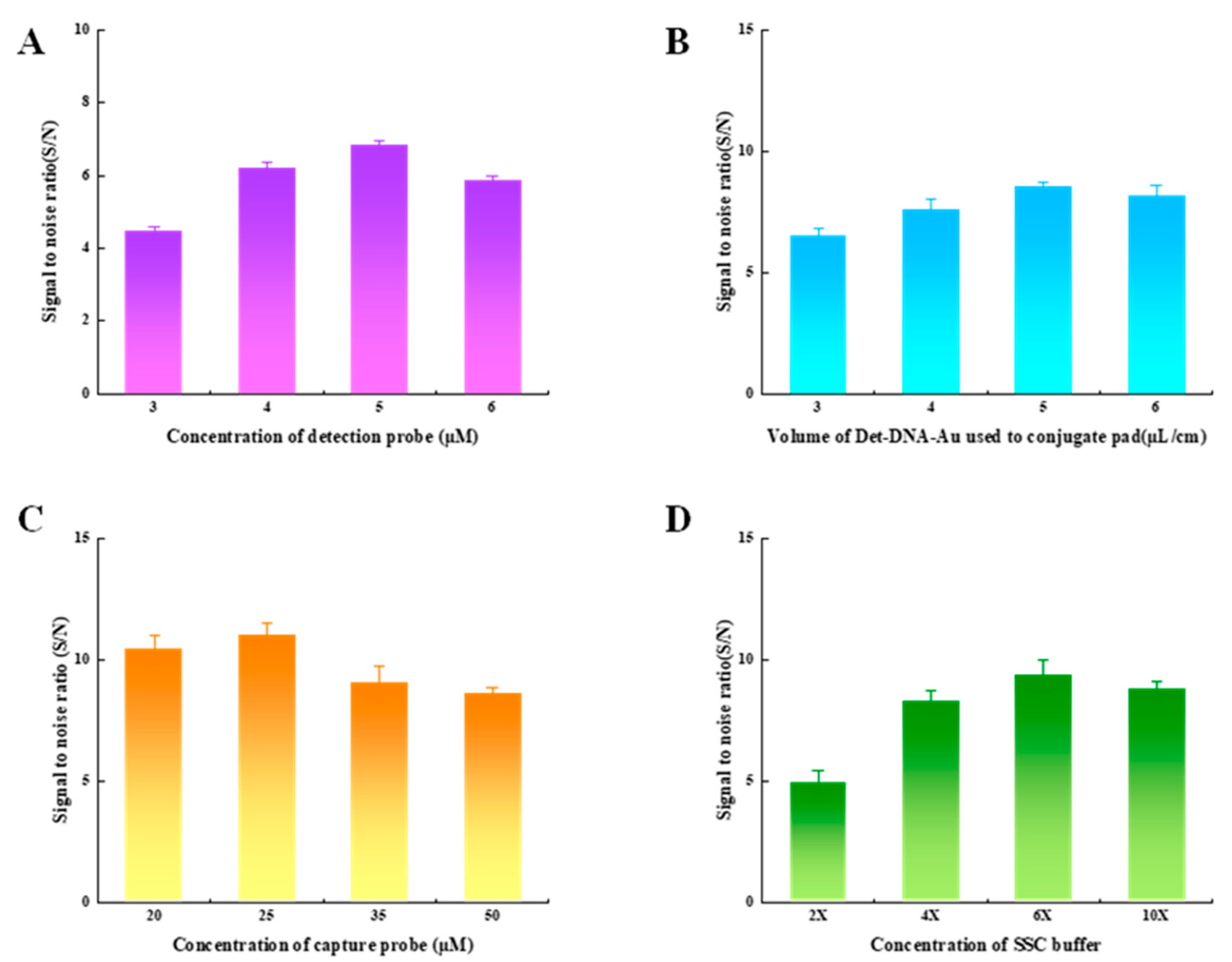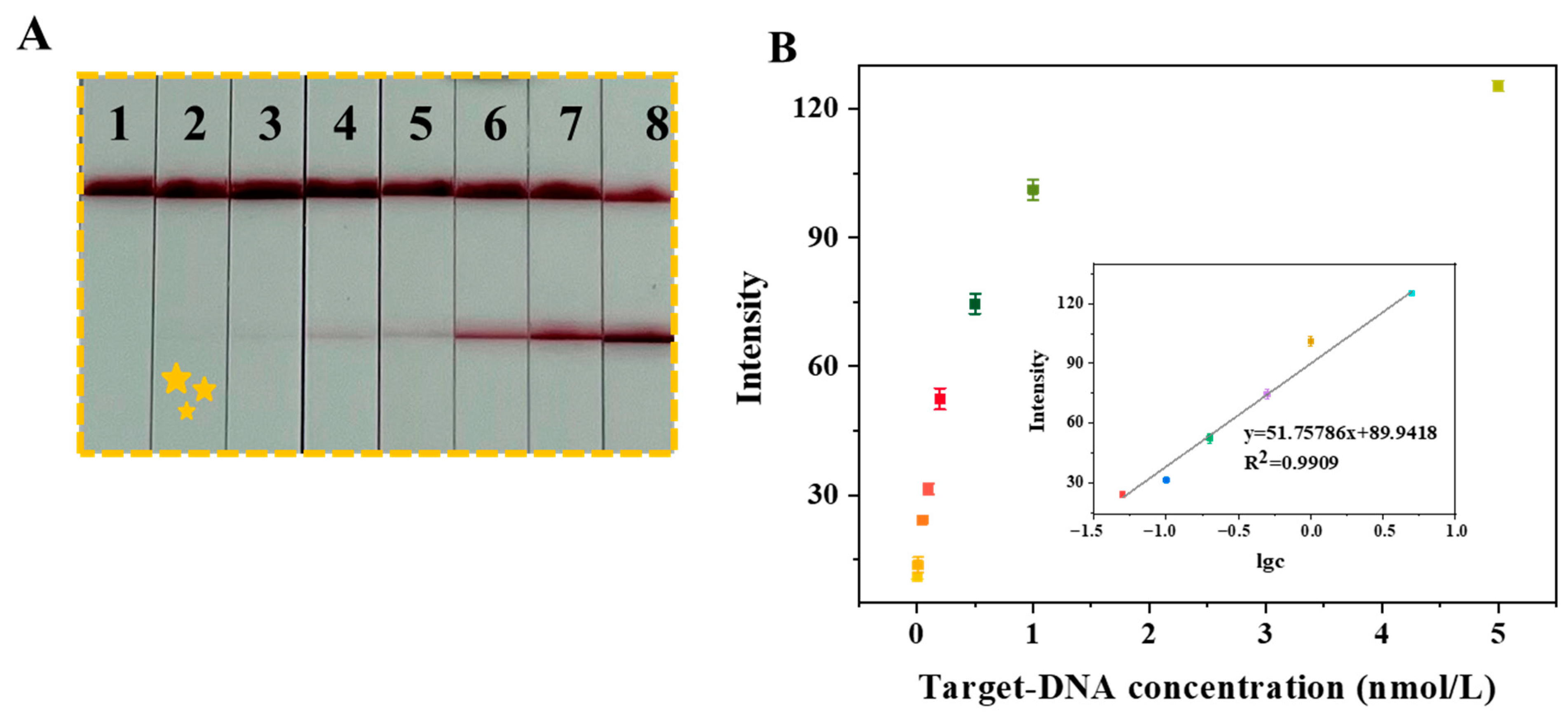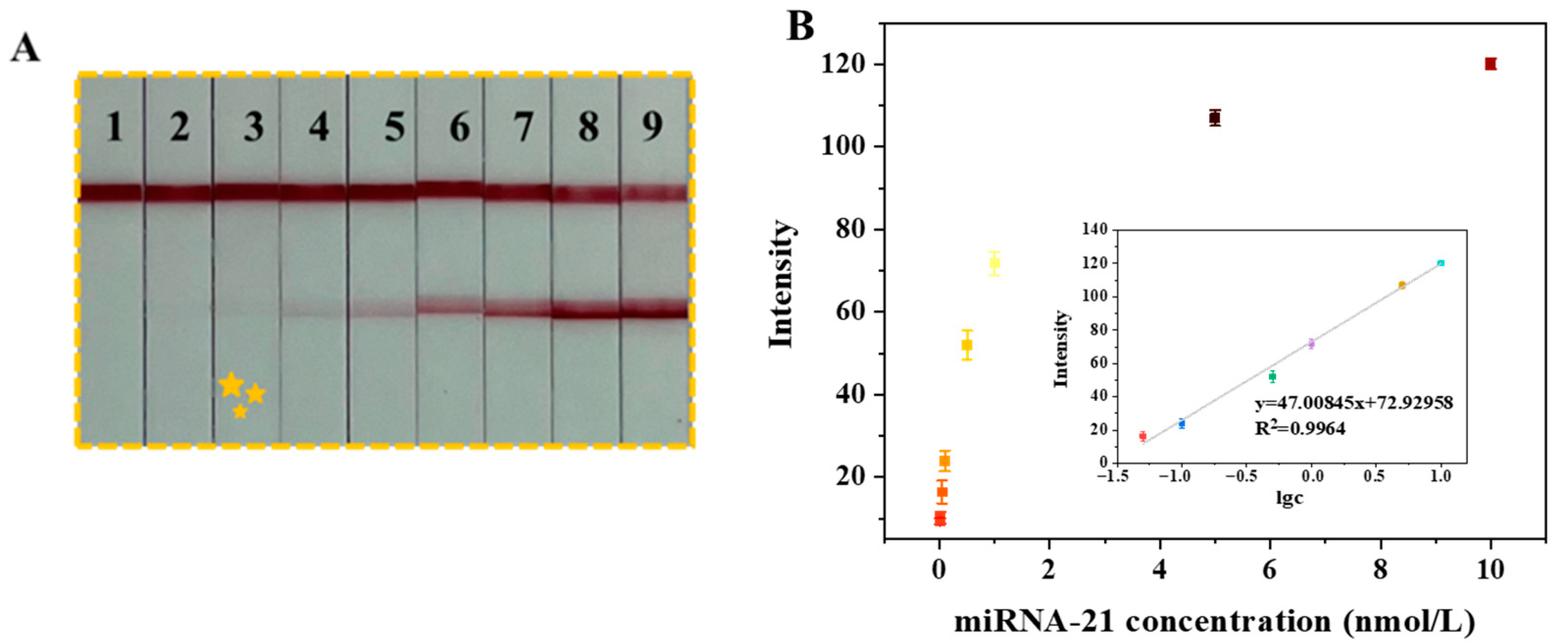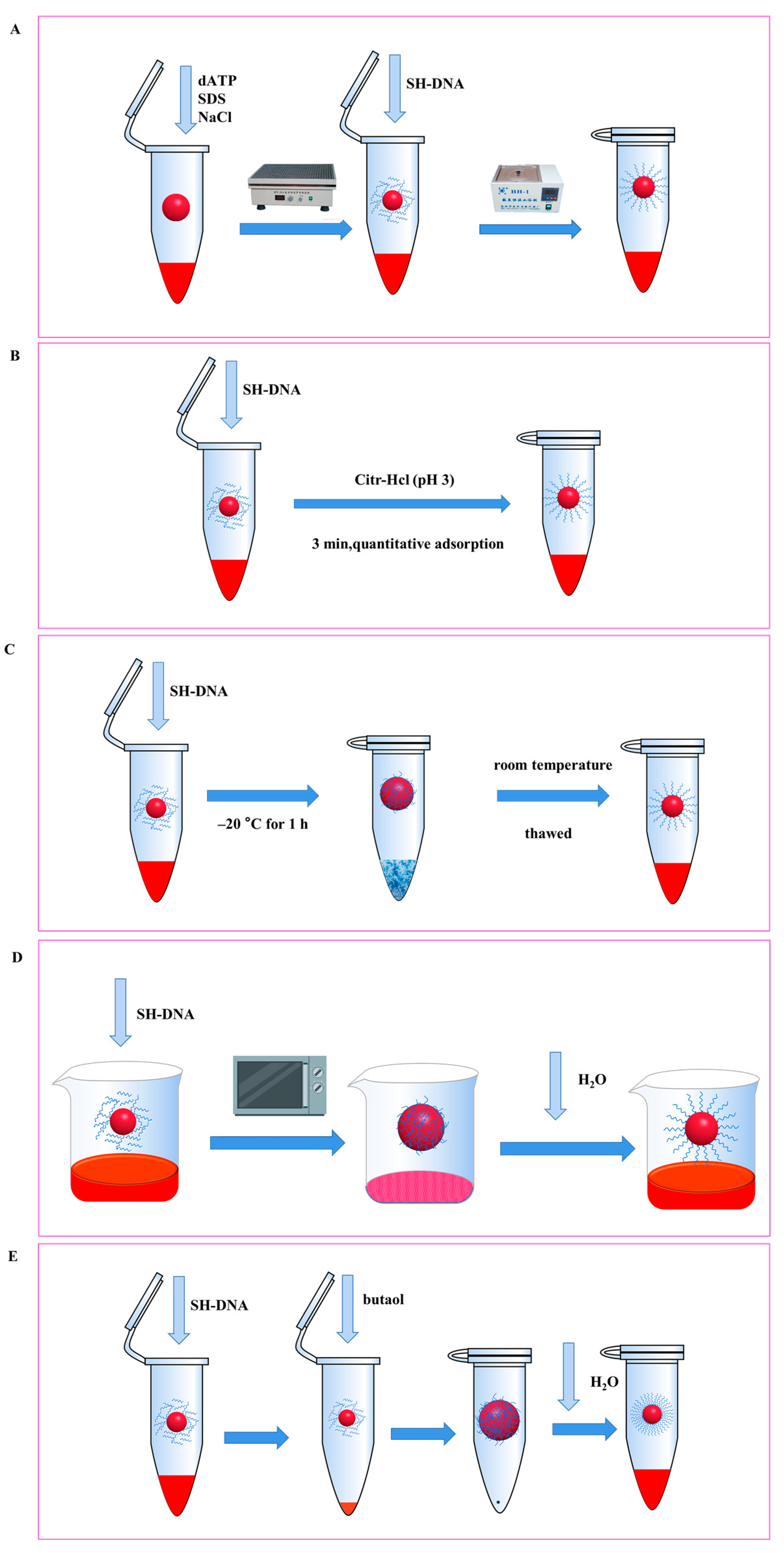Comparison of DNA–Gold Nanoparticle Conjugation Methods: Application in Lateral Flow Nucleic Acid Biosensors
Abstract
:1. Introduction
2. Results and Discussions
2.1. Performance Comparison of LFNABs Prepared with Five DNA–AuNP Conjugation Methods
2.2. Optimization of Experimental Parameters
2.3. Analytical Performances
2.4. Detecting miRNA-21 with the Optimized LFNAB
3. Materials and Methods
3.1. Instrumentation and Reagents
3.2. Preparation of DNA–AuNP Conjugates
3.2.1. Preparation of AuNPs
3.2.2. Preparation of DNA–AuNP Conjugates
Preparation of DNA–AuNP Conjugates Using the Salt-Aging Method (Scheme 2A) [32]
Preparation of DNA–AuNP Conjugates Using the Low-pH Method (Scheme 2B) [33]
Preparation of DNA–AuNP Conjugates Using the Freeze–Thaw Method (Scheme 2C) [34]
Preparation of DNA–AuNP Conjugates Using the Microwave-Assisted Dry Heating Method (Scheme 2D) [36]
Preparation of DNA–AuNP Conjugates Using the Butanol Dehydration Method (Scheme 2E) [35]
3.3. Assembly of the Lateral Flow Nucleic Acid Biosensor (LFNAB)
3.4. Lateral Flow Assay and Signal Analysis
3.5. Detection of microRNAs in Serum Samples
4. Conclusions
Supplementary Materials
Author Contributions
Funding
Institutional Review Board Statement
Informed Consent Statement
Data Availability Statement
Conflicts of Interest
Sample Availability
References
- Zheng, C.; Wang, K.; Zheng, W.; Cheng, Y.; Li, T.; Cao, B.; Jin, Q.; Cui, D. Rapid developments in lateral flow immunoassay for nucleic acid detection. Analyst 2021, 146, 1514–1528. [Google Scholar] [CrossRef]
- Lie, P.; Liu, J.; Fang, Z.; Dun, B.; Zeng, L. A lateral flow biosensor for detection of nucleic acids with high sensitivity and selectivity. Chem. Commun. 2012, 48, 236–238. [Google Scholar] [CrossRef]
- Hu, J.; Wang, L.; Li, F.; Han, Y.L.; Lin, M.; Lu, T.J.; Xu, F. Oligonucleotide-linked gold nanoparticle aggregates for enhanced sensitivity in lateral flow assays. Lab Chip. 2013, 13, 4352–4357. [Google Scholar] [CrossRef]
- Ngom, B.; Guo, Y.; Wang, X.; Bi, D.R. Development and application of lateral flow test strip technology for detection of infectious agents and chemical contaminants: A review. Anal. Bioanal. Chem. 2010, 397, 1113–1135. [Google Scholar] [CrossRef]
- Kumar, P.; Sarkar, N.; Singh, A.; Kaushik, M. Nanopaper Biosensors at Point of Care. Bioconjug. Chem. 2022, 33, 1114–1130. [Google Scholar] [CrossRef] [PubMed]
- Wang, J.; Zhu, L.G.; Li, T.S.; Li, X.Y.; Huang, K.L.; Xu, W.T. Multiple functionalities of functional nucleic acids for developing high-performance lateral flow assays. TrAC Trends Anal. Chem. 2022, 148, 116529. [Google Scholar] [CrossRef]
- Mao, X.; Ma, Y.Q.; Zhang, A.G.; Zhang, L.R.; Zeng, L.G.; Liu, G.D. Disposable nucleic acid biosensors based on gold nanoparticle probes and lateral flow strip. Anal. Chem. 2009, 81, 1660–1668. [Google Scholar] [CrossRef]
- Xu, Y.; Liu, Y.H.; Wu, Y.; Xia, X.H.; Liao, Y.Q.; Li, Q.G. Fluorescent probe-based lateral flow assay for multiplex nucleic acid detection. Anal. Chem. 2014, 86, 5611–5614. [Google Scholar] [CrossRef] [PubMed]
- Mao, X.; Wang, W.; Du, T.E. Dry-reagent nucleic acid biosensor based on blue dye doped latex beads and lateral flow strip. Talanta 2013, 114, 248–253. [Google Scholar] [CrossRef]
- Qiu, W.W.; Xu, H.; Takalkar, S.; Gurung, A.S.; Liu, B.; Zheng, Y.F.; Guo, Z.B.; Baloda, M.; Baryeh, K.; Liu, G.D. Carbon nanotube-based lateral flow biosensor for sensitive and rapid detection of DNA sequence. Biosens. Bioelectron. 2015, 64, 367–372. [Google Scholar] [CrossRef]
- Yu, Q.C.; Zhang, J.; Qiu, W.W.; Li, K.; Qian, L.S.; Zhang, X.J.; Liu, G.D. Gold nanorods-based lateral flow biosensors for sensitive detection of nucleic acids. Microchim. Acta 2021, 188, 133–140. [Google Scholar] [CrossRef] [PubMed]
- Zhang, J.; Tang, L.M.; Yu, Q.C.; Qiu, W.W.; Li, K.; Cheng, L.L.; Zhang, T.T.; Qian, L.S.; Zhang, X.J.; Liu, G.D. Gold-platinum nanoflowers as colored and catalytic labels for ultrasensitive lateral flow MicroRNA-21 assay. Sens. Actuators B Chem. 2021, 344, 130325–130331. [Google Scholar] [CrossRef]
- Takalkar, S.; Baryeh, K.; Liu, G.D. Fluorescent Carbon Nanoparticle-Based Lateral Flow Biosensor for Ultrasensitive Detection of DNA. Biosens. Bioelectron. 2017, 98, 147–154. [Google Scholar] [CrossRef]
- Sapountzi, E.A.; Tragoulias, S.S.; Kalogianni, D.P.; Ioannou, P.C.; Christopoulos, T.K. Lateral flow devices for nucleic acid analysis exploiting quantum dots as reporters. Anal. Chim. Acta 2015, 864, 48–54. [Google Scholar] [CrossRef]
- Lee, K.X.; Shameli, K.; Yew, Y.P.; Teow, S.Y.; Jahangirian, H.; Rafiee-Moghaddam, R.; Webster, T.J. Recent developments in the facile bio-synthesis of gold nanoparticles (AuNPs) and their biomedical applications. Int. J. Nanomed. 2020, 15, 275–300. [Google Scholar] [CrossRef]
- Yeh, Y.C.; Creran, B.; Rotello, V.M. Gold nanoparticles: Preparation, properties, and applications in bionanotechnology. Nanoscale 2012, 4, 1871–1880. [Google Scholar] [CrossRef]
- Kohout, C.; Santi, C.; Polito, L. Anisotropic gold nanoparticles in biomedical applications. Int. J. Mol. Sci. 2018, 19, 3385. [Google Scholar] [CrossRef]
- Saha, K.; Agasti, S.S.; Kim, C.; Li, X.; Rotello, V.M. Gold nanoparticles in chemical and biological sensing. Chem. Rev. 2012, 112, 2739–2779. [Google Scholar] [CrossRef] [PubMed]
- Gupta, A.; Moyano, D.F.; Parnsubsakul, A.; Papadopoulos, A.; Wang, L.S.; Landis, R.F.; Das, R.; Rotello, V.M. Ultrastable and Biofunctionalizable Gold Nanoparticles. ACS Appl. Mater. Interfaces 2016, 8, 14096–14101. [Google Scholar] [CrossRef]
- Cutler, J.I.; Auyeung, E.; Mirkin, C.A. Spherical nucleic acids. J. Am. Chem. Soc. 2012, 134, 1376–1391. [Google Scholar] [CrossRef]
- Barnaby, S.N.; Perelman, G.A.; Kohlstedt, K.L.; Chinen, A.B.; Schatz, G.C.; Mirkin, C.A. Design considerations for RNA spherical nucleic acids (SNAs). Bioconjug. Chem. 2016, 27, 2124–2131. [Google Scholar] [CrossRef]
- Wang, Z.; Ma, L. Gold nanoparticle probes. Coord. Chem. Rev. 2009, 253, 1607–1618. [Google Scholar] [CrossRef]
- Kapadia, C.H.; Melamed, J.R.; Day, E.S. Spherical nucleic acid nanoparticles: Therapeutic potential. BioDrugs 2018, 32, 297–309. [Google Scholar] [CrossRef]
- Kumar, D.; Saini, N.; Jain, N.; Sareen, R.; Pandit, V. Gold nanoparticles: An era in bionanotechnology. Expert Opin. Drug Deliv. 2013, 10, 397–409. [Google Scholar] [CrossRef]
- Sharifi, M.; Attar, F.; Saboury, A.A.; Akhtari, K.; Hooshmand, N.; Hasan, A.; El-Sayed, M.A.; Falahati, M. Plasmonic gold nanoparticles: Optical manipulation, imaging, drug delivery and therapy. J. Control. Release 2019, 311, 170–189. [Google Scholar] [CrossRef]
- Elahi, N.; Kamali, M.; Baghersad, M.H. Recent biomedical applications of gold nanoparticles: A review. Talanta 2018, 184, 537–556. [Google Scholar] [CrossRef]
- Goddard, Z.R.; Marín, M.J.; Russell, D.A.; Searcey, M. Active targeting of gold nanoparticles as cancer therapeutics. Chem. Soc. Rev. 2020, 49, 8774–8789. [Google Scholar] [CrossRef]
- Giljohann, D.A.; Seferos, D.S.; Prigodich, A.E.; Patel, P.C.; Mirkin, C.A. Gene regulation with polyvalent siRNA−nanoparticle conjugates. J. Am. Chem. Soc. 2009, 131, 2072–2073. [Google Scholar] [CrossRef]
- Huschka, R.; Zuloaga, J.; Knight, M.W.; Brown, L.V.; Nordlander, P.; Halas, N.J. Light-induced release of DNA from gold nanoparticles: Nanoshells and nanorods. J. Am. Chem. Soc. 2011, 133, 12247–12255. [Google Scholar] [CrossRef] [PubMed]
- Mirkin, C.A.; Letsinger, R.L.; Mucic, R.C.; Storhoff, J.J. A DNA-based method for rationally assembling nanoparticles into macroscopic materials. Nature 1996, 382, 607–609. [Google Scholar] [CrossRef] [PubMed]
- Hurst, S.J.; Lytton-Jean, A.K.R.; Mirkin, C.A. Maximizing DNA loading on a range of gold nanoparticle sizes. Anal. Chem. 2006, 78, 8313–8318. [Google Scholar] [CrossRef]
- He, Y.; Zhang, S.; Zhang, X.; Baloda, M.; Gurung, A.S.; Xu, H.; Zhang, X.; Liu, G. Ultrasensitive nucleic acid biosensor based on enzyme–gold nanoparticle dual label and lateral flow strip biosensor. Biosens. Bioelectron. 2011, 26, 2018–2024. [Google Scholar] [CrossRef] [PubMed]
- Zhang, X.; Servos, M.R.; Liu, J. Instantaneous and quantitative functionalization of gold nanoparticles with thiolated DNA using a pH-assisted and surfactant-free route. J. Am. Chem. Soc. 2012, 134, 7266–7269. [Google Scholar] [CrossRef] [PubMed]
- Liu, B.; Liu, J. Freezing directed construction of bio/nano interfaces: Reagentless conjugation, denser spherical nucleic acids, and better nanoflares. J. Am. Chem. Soc. 2017, 139, 9471–9474. [Google Scholar] [CrossRef]
- Hao, Y.; Li, Y.; Song, L.; Deng, Z. Flash synthesis of spherical nucleic acids with record DNA density. J. Am. Chem. Soc. 2021, 143, 3065–3069. [Google Scholar] [CrossRef]
- Huang, M.; Xiong, E.; Wang, Y.; Hu, M.; Yue, H.; Tian, T.; Zhu, D.; Liu, H.; Zhou, X. Fast microwave heating-based one-step synthesis of DNA and RNA modified gold nanoparticles. Nat. Commun. 2022, 13, 968. [Google Scholar] [CrossRef]
- Kor, K.; Turner, A.P.F.; Zarei, K.; Atabati, M.; Beni, V.; Mak, W.C. Structurally responsive oligonucleotide-based single-probe lateral-flow test for detection of miRNA-21 mimics. Anal. Bioanal. Chem. 2016, 408, 1475–1485. [Google Scholar] [CrossRef] [PubMed]
- Chen, T.; Xu, Y.; Wei, S.; Li, A.; Huang, L.; Liu, J.Q. A signal amplification system constructed by bi-enzymes and bi-nanospheres for sensitive detection of norepinephrine and miRNA. Biosens. Bioelectron. 2018, 124–125, 224–232. [Google Scholar] [CrossRef]
- Yao, M.; Lv, X.; Deng, Y.; Rasheed, M. Specific and simultaneous detection of micro RNA 21 and let-7a by rolling circle amplification combined with lateral flow strip. Anal. Chim. Acta 2019, 1055, 115–125. [Google Scholar] [CrossRef]
- Gao, X.; Xu, H.; Baloda, M.; Gurung, A.S.; Xu, L.P.; Wang, T.; Zhang, X.; Liu, G. Visual detection of microRNA with lateral flow nucleic acid biosensor. Biosens. Bioelectron. 2014, 54, 578–584. [Google Scholar] [CrossRef]
- Sayers, J.; Payne, R.J.; Winssinger, N. Peptide nucleic acid-templated selenocystine-selenoester ligation enables rapid miRNA detection. Chem. Sci. 2018, 9, 896–903. [Google Scholar] [CrossRef] [PubMed]







| Detection Target | Labels | LOD | Ref. |
|---|---|---|---|
| miRNA-21 | AuNPs | 115 pM | [37] |
| miRNA-21 | AuNPs | 70 pM | [38] |
| miRNA-21 | RCA, AuNPs | 40 pM | [39] |
| miRNA-215 | AuNPs | 60 pM | [40] |
| miRNA-31 | AuNPs | 33 pM | [41] |
| miRNA-21 | AuNPs | 20 pM | This work |
| Sample Number | Spiked Concentration (nM) | Measured Concentration (nM) | Recovery (%) | RSD (%) |
|---|---|---|---|---|
| 1 | 0.05 | 0.0481 | 96.2 | 2.24 |
| 2 | 0.5 | 0.4739 | 94.78 | 2.06 |
| 3 | 5 | 4.906 | 98.12 | 1.16 |
| Method | Concentrations of DNA (μM) | Volume of DNA (μL) | Concentrations of AuNPs (nM) | Volume of AuNPs (μL) | pH | Reaction Temperature | Buffer | Linkers |
|---|---|---|---|---|---|---|---|---|
| salt-aging | 100 | 5 | 28 | 100 | - | 60 °C | - | dATP, thoil |
| low-pH | 100 | 5 | 28 | 100 | 3 | Room temperature | Citrate, HEPES | thoil |
| freeze-thaw | 100 | 5 | 28 | 100 | - | −20 °C | - | thoil |
| microwave-assisted heating dry | 100 | 5 | 28 | 100 | - | 80–90 °C | - | thoil |
| butanol dehydration | 100 | 5 | 28 | 100 | - | Room temperature | - | thoil |
Disclaimer/Publisher’s Note: The statements, opinions and data contained in all publications are solely those of the individual author(s) and contributor(s) and not of MDPI and/or the editor(s). MDPI and/or the editor(s) disclaim responsibility for any injury to people or property resulting from any ideas, methods, instructions or products referred to in the content. |
© 2023 by the authors. Licensee MDPI, Basel, Switzerland. This article is an open access article distributed under the terms and conditions of the Creative Commons Attribution (CC BY) license (https://creativecommons.org/licenses/by/4.0/).
Share and Cite
Ding, Q.; Qiu, W.; Sun, C.; Ren, H.; Liu, G. Comparison of DNA–Gold Nanoparticle Conjugation Methods: Application in Lateral Flow Nucleic Acid Biosensors. Molecules 2023, 28, 4480. https://doi.org/10.3390/molecules28114480
Ding Q, Qiu W, Sun C, Ren H, Liu G. Comparison of DNA–Gold Nanoparticle Conjugation Methods: Application in Lateral Flow Nucleic Acid Biosensors. Molecules. 2023; 28(11):4480. https://doi.org/10.3390/molecules28114480
Chicago/Turabian StyleDing, Qiaoling, Wanwei Qiu, Chunxue Sun, Hongxin Ren, and Guodong Liu. 2023. "Comparison of DNA–Gold Nanoparticle Conjugation Methods: Application in Lateral Flow Nucleic Acid Biosensors" Molecules 28, no. 11: 4480. https://doi.org/10.3390/molecules28114480
APA StyleDing, Q., Qiu, W., Sun, C., Ren, H., & Liu, G. (2023). Comparison of DNA–Gold Nanoparticle Conjugation Methods: Application in Lateral Flow Nucleic Acid Biosensors. Molecules, 28(11), 4480. https://doi.org/10.3390/molecules28114480






